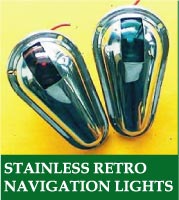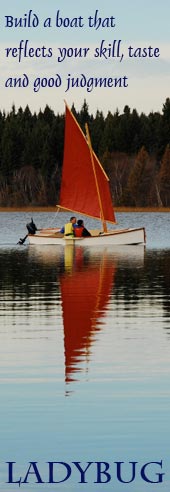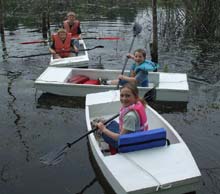
 Custom Search
|
| boat plans |
| canoe/kayak |
| electrical |
| epoxy/supplies |
| fasteners |
| gear |
| gift certificates |
| hardware |
| hatches/deckplates |
| media |
| paint/varnish |
| rope/line |
| rowing/sculling |
| sailmaking |
| sails |
| tools |
| join |
| home |
| indexes |
| classifieds |
| calendar |
| archives |
| about |
| links |
| Join Duckworks Get free newsletter CLICK HERE |
|
|
| How I Got Into Boatbuilding |
by Josh Withe - Merrimack River Valley, New England - USA |
I couldn’t avoid it, it was passed on in my blood, that’s my story and I’m sticking to it! My grandfather loved the water, he grew up boating and swimming in Connecticut, in fact he was an alternate for the US Olympic swim team in ‘36. He was also an army ranger, but just before the entry of the US into WWII, he cut his shoulder to the bone diving into a river. He was told he would never use his arm again, and discharged from the army. After his arm healed (perfectly thanks to the power of faith) he put his boyhood hobby to use as a radio officer in the US merchant Marine. He spent the war and a few years afterwards traveling the North Atlantic on liberty ships. As a former Ranger, he also trained the anti-aircraft gunners the army sent them (usually washouts from army boot camp), most of them showed up aboard the ship with no clue about gunnery, or even how to load the AA guns. He survived the war with memories of torpedo attacks on his convoys, even watching torpedoes just miss his ship, and a direct hit on the bridge of his ship in the English channel during an emergency ammunition run to support the battle of the bulge. He was the only officer that survived the hit, as his radio equipment took the brunt of the blast. When he came too he was in charge of the ship. After the war he spent many hours out on an old wooden motor boat found abandoned on a Maine beach. Since he also kept a collection of worn out outboard motors, my dad spent many hours rowing the boat back from wherever the motor quit at, while my grandfather tried to get the motor restarted. My dad went on to row crew for Northeastern University, so that all that rowing paid off. My dad inherited that old motor boat, but other than one summer when we left it at a friends house on a pond in Maine, we never used it. We finally dumped it off the trailer in ‘85 and left it to die slowly beside the ice pond. When I was about 5 years old, my parents bought a Coleman canoe. This was back when you got a flat hull and a box of screws and poles. I still remember my dad wrestling the hull into shape, and somewhere we have a slide of me sitting in the canoe. Thanks to that canoe we finally got to spend more than a few days a year on the water. Before that my parents had borrowed boats for our yearly camping trip, but those camping trips are usually remembered by the “year something bad happened”. Like the year I hit my sister in the head with a horseshoe, or the year my dad split his scalp on the trunk lid, the year our tent got flooded and my sister and I woke up on opposite sides of the tent than when we fell asleep, with her head in a puddle, and the year my dad got bit by a dog and spent the rest the week fighting the infection. That was the time I discovered I could pull the canoe around with my family riding along. With my dad out of commission, I paddled like crazy in the bow, while my mom did the steering. We didn’t go camping again after that… After we moved to our new house on the ice pond, my sister and I took the canoe on the pond a few times a week, until the pond was drained. See push poles on the ice pond.
Within a couple years I read about a rowing club for teens being started a few miles away on the Merrimack river. Five miles was an easy bike ride to get out rowing, most of the time alone, but also in a group when a bunch of us got a ride from one of our high school teachers. Seven years later we finally began building a competitive boat. That spring we launched a Phil Bolger stretched gull dory. While we had a boat that had been considered competitive in the traditional style racing, most of the rowers were moving on to faster designs. I loved the Stretched gull and spent many hours in it. My wife and I even won first in our class in it not long after we were married. Living in Maine, with the rowing club in Massachusetts, I had to give up the rowing club and dories. To get my boating fix I borrowed my dad's canoe, for the next seven years I dreamed of building a fast rowboat, but settled for adding outriggers and oar locks to the canoe. Only after my parents took their canoe back, and a couple years lugging a 17’ Coleman canoe, did I get into my dream of building a boat. I ended up working nights, the hours put me out of sync with my family. I began reading all about the mouseboat on Yahoo, after finding a link to the website in Messing About In Boats. At one point I read every single thread on the site all the way back to the first posts. While I felt I knew everything about building a mouse you could read, I had this idea that wooden boat building was a precision game, much like building airplanes or race cars. I got this from building the stretched gull dory in the rowing club, we built it in the shop of a professional boat builder and carpenter, somebody who actually worked at Lowell's Boat shop in Amesbury. He couldn’t let a group of amateurs build a bad boat in his shop, so he spent plenty of time perfecting our build and the boat came out looking like furniture. I knew I couldn’t make a boat like that and didn’t know then that there are plenty of boats that the builder knows every defect and oops, but they float and go just like the furniture boats. I finally got my nerve up and drew out a micro mouse on a sheet of cheap Luan (amazing how bad the cheap stuff has gotten in just a few years at the depot) then spent a few hours leveling the tops of two sawhorses, attaching 2x4’s to them, and marking out the stations exactly (note, this is not how you build a mouse! instead, wire or tie wrap the hull together as fast as possible on any relatively flat surface, then get busy gluing the seams asap, before the cheap ply you bought starts to warp, nobody cares if your mouse is warped, they think it is cute/want to buy it/want to know where they can get one/can you build one for them/ are just plain jealous that you are on the water and they are not). It took me all summer to build that mouse. The garage was not heated so it got no attention all winter, then the next summer I finally dragged it over to a little know Maine pond hidden in the woods, and launched it where nobody could see it fail. It floated! Not only that, it was a nice boat, easy to paddle and stable! Fortunately somebody brought their kids over to swim at the pond, so I not only got them to take a picture, but got the first of a million longing looks from kids, and compliments/questions about finding the plans from adults. Then I put the boat away and didn’t touch it again for a whole year!
If you read Seagull the mouseboat you know most of the rest of the story. Since then I’ve gone on to build eight mouseboats (a record?) two years ago I built two minimice at the same time twin mouseboats, and another micro scuffy, the proper way, cut, tye-wrapped, taped and painted in a month and a half for all three. Yes one is wracked, (only I know) and one has a splice where I cut the curve wrong (only I know where) but it doesn’t matter, just about every person I meet wants to know about the “cute little boats”. All they know is my kids are having a blast in their own boats, and they/their kids are not.
I finally built a “real” boat, a Michalak Larsboat - Duet last summer, but then went off on a wild tangent, building my eighth mouse Sea Foam out of foam (weighs half of a plywood mouse). A foam SUP (incomplete, thank you ADD), and a foam kayak that was the prototype to a plan getting lots of attention on Instructables.com right now. See Sawfish. My brain is still designing the next boat, I just can’t build it now because I’m tied up building my foam camper (another story for another site) If you have kids you owe it to them to get them out on the water early, all four of ours have been boating since birth, they all have fallen asleep on a boat cushion watching the stars, and rocked by the waves. My oldest is just finishing her first boat (I showed her what to do and she did just about all of it), all four love the water, and should be addicted for life. Seagull is still going strong, now on her second captain, for a boat built of cheap luan and a ton of PL Premium many years ago, she is not showing her age. Some links: seagull and the rest of the mice album; |
To comment on Duckworks articles, please visit one of the following:
|
 |






